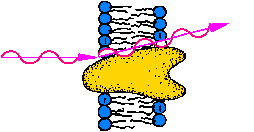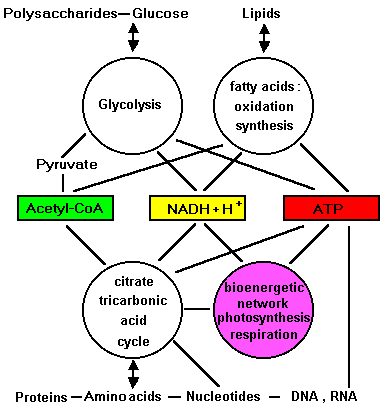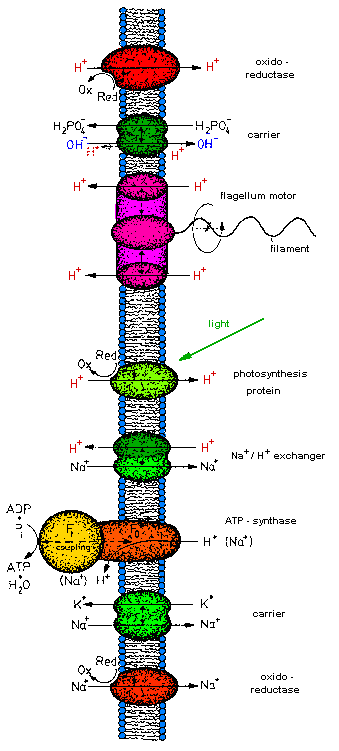 |
Membrane Pharmacy Structure Dynamics
Research group : Priv.Doz. Dr.
Thomas Nawroth
BioEnergetics
|

|
|
Fig.1: The bioenergetic network
of membrane proteins delivers 99% of the energy
(ATP
and reduction work, NADH) for cellular functions in those organisms
capable of respiration or photosynthesis. This is one of the four common
cellular reaction cycles, which are linked by common substrates and products
(Acteyl-CoEnzyme-A, NADH, ATP) (after T20).
|
The objects of science by the MPSD group are proteins capable of molecular
motion and membranes. Those systems are the constituents of
the bioerergetic system of all cells beein capable of photosynthesis or
respiration, e.g. man. As depicted in Fig.1, this system delivers about
99% of the energy in those biological systems. A further example of motile
systems are the membrane receptors, which carry information from outside
the cell to the interior by a series of molecular motions, i.e. conformational
changes. Figure2 concludes some common features of bioenergetic systems:
they contain an ion-tight membrane, ion pumping proteins and energy converters.
Thus the bioenergetic proteins bear at least two different, but energetically
coupled activities. These membrane proteins couple the (photo)chemical
reaction and the ion translocation by molecular motion. Between the two
processes the energy, e.g. 30 kJ/mole, is stored inside the protein. In
this respect the bioenergetic ion pumps resemble the motor proteins, e.g.
in muscle. In the case of ATP-synthase the catalytic domains bear
significant homology to several motor proteins, e.g. Kinesin, Dynein,
the ribosomal elongation factor EF-Tu and the intracellular switch
ras-p21.
Additionally the bioenergetic proteins show significant molecular regulation,
i.e. a gear of the catalytic activity. In both cases, energy transfer reaction
and regulation, the structure-function relation is the key for the biological
activity. Thus the investigation of molecular structure with the isolated
purified proteins is a focus of science. This is done by neutron-
and X-ray scattering of solutions or diffraction. In case of heterogenous
membranes freeze fracture electron microscopy is required. In case of ATP-synthase
and its catalytic head, F1ATPase, from the aerobic bacterium
Micrococcus
luteus a scheme of conformational changes
during regulation was found and a film
of molecur motion during enzymatic ATP-hydrolysis was estimated.
 |
Fig.1: The bioenergetic system
consists of membranes, which are impermeable to special ions (H+,
Na+) and a network of incorporated energy converting
membrane proteins, which are ion pumps. In most organisms these are proton
pumps, whereas sodium pumps
are present in some special systems (e.g. extremophiles) and probably in
anicient species. The energy converting membrane proteins have some common
features: i) they bear at least two different active domains, one translocation
the ions across the membrane, the other catalyzing a (photo)chemical reaction
or mechanical work; ii) the energy converters are capable of molecular
motion, which connects the two reactions (transport and catalysis); iii)
the energy is stored inside the protein between the ion transport andd
catalysis processes, probable in an energized protein conformation, i.e.
a metastable state. The energized state of the whole system is stored in
the "energized state of the membrane",
i.e. an electrochemical proton potential difference sufficient for ATP
synthesis : delta-p > 100 mV. Thus the primary cellular energy storage
is done by a physical membrane state and not in a chemical compound. The
proton pump ATP-synthase converts this local energy into a membrane-independent
compound: AdenosineTriPhosphate, ATP.
By this reaction the energy od respiration or photosynthesis becomes available
to the enzymes inside the cell, e.g. in the cytoplasm. Many species have
a H+/Na+exchanger
which links the proton- to the sodium-world (after T20). |
email to: nawroth@MPSD.de
update : 15.10.2013



